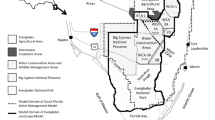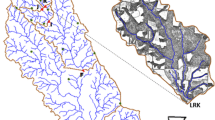Abstract
The coupled regional simulation model, and the transport and reaction simulation engine were recently adapted to simulate ecology, specifically Typha domingensis (Cattail) dynamics in the Everglades. While Cattail is a native Everglades species, it has become invasive over the years due to an altered habitat over the last few decades, taking over historically Cladium jamaicense (Sawgrass) areas. Two models of different levels of algorithmic complexity were developed in previous studies, and are used here to determine the impact of various management decisions on the average Cattail density within Water Conservation Area 2A in the Everglades. A Global Uncertainty and Sensitivity Analysis was conducted to test the importance of these management scenarios, as well as the effectiveness of using zonal statistics. Management scenarios included high, medium and low initial water depths, soil phosphorus concentrations, initial Cattail and Sawgrass densities, as well as annually alternating water depths and soil phosphorus concentrations, and a steadily decreasing soil phosphorus concentration. Analysis suggests that zonal statistics are good indicators of regional trends, and that high soil phosphorus concentration is a pre-requisite for expansive Cattail growth. It is a complex task to manage Cattail expansion in this region, requiring the close management and monitoring of water depth and soil phosphorus concentration, and possibly other factors not considered in the model complexities. However, this modeling framework with user-definable complexities and management scenarios, can be considered a useful tool in analyzing many more alternatives, which could be used to aid management decisions in the future.







Similar content being viewed by others
Abbreviations
- RSM:
-
Regional Simulation Model
- RTE:
-
coupled RSM TARSE model applied towards Ecology
- TARSE:
-
Transport and Reaction Simulation Engine
- SFWMD:
-
South Florida Water Management District
- SFWMM:
-
South Florida Water Management Model
- WCA2A:
-
Water Conservation Area 2A
- HSE:
-
Hydrologic Simulation Engine
- GUSA:
-
Global Uncertainty and Sensitivity Analysis
- CERP:
-
Comprehensive Everglades Restoration Plan
- USACE:
-
United States Army Corps of Engineers
- SIS:
-
Sequential Indicator Simulation
- DM:
-
Delta Mean
- CATGF:
-
Cattail Growth Factor
- SAWGF:
-
Sawgrass Growth Factor
- DepthMgmt:
-
Depth Management scenario
- PMgmt:
-
Phosphorus Management scenario
References
Ascough JC, Maier HR, Ravalico JK, Strudley MW (2008) Future research challenges for incorporation of uncertainty in environmental and ecological decision-making. Ecol Model 219:383–399
Brown MT, Cohen MJ, Bardi E, Ingwersen WW (2006) Species diversity in the Florida Everglades, USA: a systems approach to calculating biodiversity. Aqua Sci 68:254–277
Chen ZM, Xia XH, Tang HS, Li SC, Deng Y (2010) Emergy based ecological assessment of constructed wetland for municipal wastewater treatment: methodology and application to the Beijing wetland. J Environ Inform 15(2):62–73
DeBusk WF, Reddy KR, Koch MS, Wang Y (1994) Spatial distribution of soil nutrients in a nothern-Everglades marsh: water conservation area 2A. Soil Soc Am 58:543–552
Fitz CH, Kiker GA, Kim JB (2011) Integrated ecological modeling and decision analysis within the Everglades landscape. Environ Sci Technol 41:517–547
Fitz CH, Trimble B (2006) Everglades Landscape Model (ELM). http://my.sfwmd.gov/portal/page/portal/xweb%20-%20release%202/elm. Accessed 29 July 2016
Glennon R (2002) Water follies – Groundwater pumping and the fate of America’s fresh waters. Island Press, Washington, DC
Grace JB (1989) Effects of water depth on Typha Latifolia and Typha domingensis. Am J Botany: 762-768.
Gross LJ (1996) ATLSS home page. http://atlss.org/. Accessed 31 July 2010.
Grunwald S, Ozborne TZ, Reddy KR (2008) Temporal trajectories of phosphorus and pedo-patterns mapped in water conservation Area 2, Everglades, Florida, USA. Geoderma 146:1–13
Grunwald S, Reddy KR, Newman S, DeBusk WF (2004) Spatial variability, distribution and uncertainty assessment of soil phosphorus in a South Florida Wetland. Environmetrics 15:811–825
Gunderson LH, Holling CS & Peterson GD (2001) Surprises and sustainability: cycles of renewal in the everglades. In: Panarchy: understanding transformations in human and natural systems. Island Press, Washington DC, pp 315–332.
Jawitz JW, Muñoz-Carpena R, Muller S, Grace KA, James AI (2008) Development, testing, and sensitivity and uncertainty analyses of a transport and reaction simulation engine (TARSE) for spatially distributed modeling of phosphorus in south Florida Peat Marsh Wetlands. Scientific Investigations Report 2008-5029. Reston, VA: United States Geological Survey.
Keen RE, Spain JD (1992) Computer simulation in biology. Wiley-Liss, New York
Krysanova V, Hattermann F, Wechsung F (2007) Implications of complexity and uncertainty for integrated modeling and impact assessment in river basins. Environ Model Software 22:701–709
Lagerwall GL, Kiker GA, Muñoz-Carpena R, Convertino M, James A, Wang N (2012) A spatially distributed, deterministic approach to modeling Typha domingensis (Cattail) in an Everglades wetland. Ecol Proc 1(2012):10
Lagerwall G, Kiker GA, Muñoz-Carpena R, Wang N (2014) Global uncertainty and sensitivity analysis of a spatially distributed ecological model. Ecol Model 275:22–30
Layzer JA (2006) Ecosystem-based solutions: restoring the Florida Everglades. In: The environmental case. 2nd ed. CQPress, Washington DC, pp 404–435.
Lieske DJ, Bender DJ (2009) Accounting for the Influence of Geographic Location and Spatial Autocorrelation in Environmental Models: A Comparative Analysis Using North American Songbirds. J Environ Inform 13(1):12–32
Lilburne L & Tarantola S (2009) Sensitivity analysis of spatial models. Int J Geogr Inform Sci 23:151–168.
Miao, S.L. & Sklar, F.H. (1998) Biomass and nutrient allocation of Sawgrass and Cattail along a nutrient gradient in the Florida Everglades. Wetlands Ecol Manage 5:245.
Messina JP, Evans TP, Manson SM, Shortridge AM, Deadman PJ, Verburg PH (2008) Complex systems models and the management of error and uncertainty. J Land Use Sci 3(1):11–25
Muller S, Muñoz-Carpena R, Kiker G (2011) Model relevance: Frameworks for exploring the complexity-sensitivity-uncertainty trilemma. Book Chapter (pp. 35–67). Climate: Global hange and Local Adaption. In: I Linkov, T. S. Bridges. Springer Dordrecht/Boston/London. Published in cooperation with NATO Scientific Affairs Division.
Newman S, Schutte J, Grace J, Rutchey K, Fontaine T, Reddy K, Pietrucha M (1998) Factors influencing Cattail Abundance in the Northern Everglades. Aqua Botany 60: 265–280.
Odum HT, Odum EC & Brown MT (2000) Wetlands management, In: Environment and society in Florida, CRC Press, Boca Raton, FL, p 197.
Rutchey K, Schall T, Sklar F (2008) Development of vegetation maps for assessing Everglades restoration progress. Wetlands 172(2):806–816
Saltelli A, Chan K, Scott EM (2004) Sensitivity analysis. John Wiley & Sons Ltd, Chichester, UK
SFWMD (2008a) RSM water quality user manual (DRAFT). South Florida Water Management District, West Palm Beach, FL, User Manual (draft)
SFWMD (2008c) WCA2A HSE Setup. Overview document. South Florida Water management District, West Palm Beach, FL
Sobol IM (2001) Global sensitivity indices for nonlinear mathematical models and their Monte Carlo estimates. IMACS 55:271–280
Tarboton KC, Irizarry-Ortiz MM, Loucks DP, Davis SM, Obeysekera JT (2004) Habitat suitability indices for evaluating water management alternatives. South Florida Water Management District, West Palm Beach, FL
Urban NH, Davis SM, Aumen NG (1993) Fluctuations in Sawgrass and Cattail densities in Everglades water conservation area 2A under varying nutrient, hydrologic, and fire regimes. Aqua Botany 46:203–223
USACE, S.F.R.O. (2010a) CERP: The Plan in Depth—Part 1. [Online]. http://www.evergladesplan.org/about/rest_plan_pt_01.aspx. Accessed 3 August 2010.
USACE, S.F.R.O. (2010b) CERP: The Plan in Depth—Part 2. [Online]. http://www.evergladesplan.org/about/rest_plan_pt_02.aspx. Accessed 3 August 2010.
Willard DA, 2010. SOFIA - FS-146-96. [Online]. http://sofia.usgs.gov/publications/fs/146-96/. Accessed 3 August 2010.
Wu Y, Sklar FH, Rutchey K (1997) Analysis and simulation of fragmentation patterns in the Everglades. Ecol Appl 7(1):268–276
Zajac ZB (2010) Global sensitivity and uncertainty analysis of spatially distributed watershed models. PhD. Dissertation. University of Florida, Gainesville, FL
Zheng C, Yang W, Yang ZF (2011) Strategies for managing environmental flows based on the spatial distribution of water quality: a case study of Baiyangdian Lake, China. J Environ Inform 18(2):84–90
Acknowledgments
Financial support for this research was provided by the South Florida Water Management District and the U.S. Geological Survey—Water Resources Research Center at the University of Florida.
Author information
Authors and Affiliations
Corresponding author
Ethics declarations
Conflict of interest
The authors declare that they have no competing interests.
Submission Declaration
The work described herein has not been published previously (except in the form of an abstract or as part of a published lecture or academic thesis), it is not under consideration for publication elsewhere, its publication is approved by all authors and tacitly or explicitly by the responsible authorities where the work was carried out, and that, if accepted, it will not be published elsewhere including electronically in the same form, in English or in any other language, without the written consent of the copyright-holder.
Authors’ contributions
GL conducted the majority of the research, Global Uncertainty and Sensitivity Analysis, and writing of the paper. GK provided ecological modeling expertise, general guidance, paper writing, and review contributions. RMC provided invaluable guidance with the statistics, running the distributed model on the high performance computing cluster, and ensured that the general logic of the paper was maintained. NW provided RSM and WCA2A expertise, supplied raw vegetation maps, and provided critical review on model design. All authors read and approved the final manuscript.
Electronic supplementary material
Rights and permissions
About this article
Cite this article
Lagerwall, G., Kiker, G., Muñoz-Carpena, R. et al. Accounting for the Impact of Management Scenarios on Typha Domingensis (Cattail) in an Everglades Wetland. Environmental Management 59, 129–140 (2017). https://doi.org/10.1007/s00267-016-0769-0
Received:
Accepted:
Published:
Issue Date:
DOI: https://doi.org/10.1007/s00267-016-0769-0




